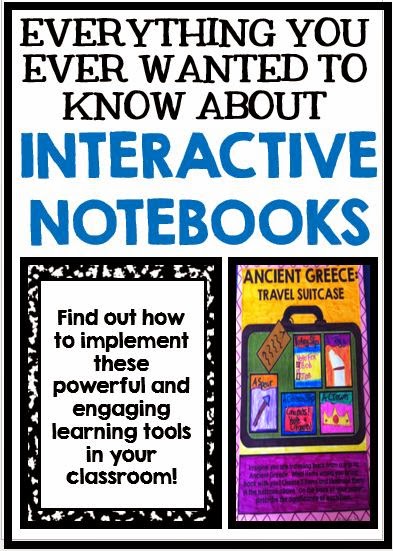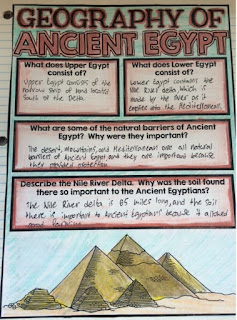If you have been following me for a while, it should be no surprise to you how much I love using Interactive Notebooks in my classroom. After first seeing them used in the Science classroom across the hall from me, I quickly fell in love - I loved the way they kept the kids organized, and how the kids had a record of their learning, that showed growth over time. The next year, I began implementing them with my grade seven and eight students, and have not looked back.
I will admit that this undertaking has been a huge work in progress. I have had many hiccups along the way, but have found that the benefits have made all of the work worth it. I have learned that Interactive Notebooks are certainly not just for elementary students, as my middle school students eagerly await opportunities to participate in anything interactive. This different way of structuring our learning shakes things up a bit, which is exactly what a lot of my disengaged teenage learners need. I am hugely passionate about using them with my students.
Research has shown many benefits to using Interactive Notebooks. To me, the very best part of using Interactive Notebooks in my classroom is that they promote engagement, creativity, and analytical thinking - all things I strive for in my middle school classroom. They keep my struggling students organized, make differentiating for my higher learners a breeze, provide a record of our learning, and become a student-created reference tool to refer back to when needed - honestly, I can't imagine how I ever structured my classes without them.
Lately, I have had a lot of people ask me about Interactive Notebooks, and how I use them in my classroom - sounds like a fun blog post to me! I really wish I had few tips before getting started, as it would have caused me to bypass some of the wrong turns I made along the way.
So... what are Interactive Notebooks, anyways?
I have seen Interactive Notebooks called many things - Reader/Writer Notebooks, Interactive Student Notebooks, Response Journals, etc. Call them what you will, they are essentially a notebook of some sort that is used to record information. The key is in the "interactive" part, which makes then fun and engaging - a hit with students of many different age groups. Basically, Interactive Notebooks allow students to take information supplied by the teacher, and merge it with their own thinking. The foldables and activities within the Interactive Notebook allow students to work with information they have gathered, creating deeper connections to the content. Instead of just taking passive notes, students are encouraged to "show what they know" by applying their knowledge in a creative way.
In "Classroom Instruction that Works", Marzano, Pickering, and Pollock state that "taking notes and summarizing information is a proven thinking strategy that helps to increase student achievement and retain new information". Providing students with information and then asking them to use thinking strategies to actually interact with it in some way helps the information to stick in their brains much more than simply listening to a lecture or taking notes from the board. Creating the foldables and activities within the Interactive Notebooks increase student abilities to organize and connect to class content.
Interactive Notebooks are powerful educational tools.
Interactive Notebooks enable students to be creative and independent thinkers and writers. They allow students to express their ideas in unique and engaging ways, and process information presented in class; as students learn new ideas, they have the opportunity to use several types of interactive writing and graphic techniques to record and process them. The ultimate goal of using Interactive Notebooks in the classroom is to teach students to be independent thinkers and note takers; Interactive Notebooks teach students about the tools and strategies needed to eventually do this on their own. The activities completed in Interactive Notebooks are so much more than cutesy cut and paste images; instead, they teach students to interact with content at a high level, and to make that content their own.
Interactive Notebooks meet the needs of a variety of learning styles.
Interactive Notebooks allow visual learners to explore new ways to share ideas, and encourages non-visual learners to become more proficient with graphic approaches in a non-threatening way. Both types of learners use the notebooks to work on their writing skills, while learning valuable note taking strategies. I have found that my kinesthetic learners enjoy moving around and using their hands to assemble the bits and pieces.
Interactive Notebooks help students to systematically organize while they learn.
Students use Interactive Notebooks to organize their thoughts and ideas. A variety of organizational techniques are used to synthesize concepts and help make sense of what they learn. The notebook allows assignments to be kept together in a regular place and in a logical order. Students who struggle with organization (and I am sure you have as many of those as I do!) often find the notebooks very helpful. Instead of a million random worksheets, students have everything organized together in one place. Our Interactive Notebooks cause us to spend a significant amount of time in class teaching these organization skills, which students are able to take with them into other subject areas.
Interactive Notebooks become portfolios of individual learning.
These creative notebooks become records of each student's growth. The teacher, student, and parents can use the notebooks to review a student's progress in writing, illustrating, recording, thinking, and organizing. They are an amazing portfolio to pull out during parent conferences. Gone are the days of gathering up and storing assignments, as now I simply have to pull out our Interactive Notebooks to show parents what we have been up to. These notebooks are an excellent summary of our learning, and parents always seem to be impressed. Student growth can clearly be seen as they progress throughout the school year.
Interactive Notebooks are a work in progress, and allow students to learn from their mistakes.
I have my students complete a new notebook at the start of each unit. Throughout the unit, notebooks are collected sporadically, and checked for completion. When improvement is needed, sticky notes with constructive criticism are added. As the notebooks are not collected for marks until the very end of a unit, students have multiple opportunities to receive feedback and improve their work before receiving a final mark.
Interactive Notebooks are valuable study tools.
As all of the information needed for each unit is contained inside the Interactive Notebook, the notebooks become comprehensive study guides created by the students themselves. Interactive Notebooks help teach students new ways to study, and the activities within the notebooks often provide students with visual pictures to help remember content. Having everything complete, organized, and in one place makes studying much easier. Interactive Notebooks also teach students to be resourceful - when they get stuck in class, or forget how to do something, they can refer back to the information they have previously gathered. They quickly become the "go to" resource for students to go over concepts they have missed or are struggling with. Throughout the course of the year, students are essentially creating their very own textbook; I can guarantee these self-created textbooks are much more meaningful to students.
Interactive Notebooks are fun, hands on, and engaging.
The activities we complete while putting together our Interactive Notebooks bring with them high levels of student engagement. The kids are actively involved, moving around, and being creative while creating things that flip, flap, and fold - these hands on activities really give students the opportunity to grasp concepts further. Interactive Notebooks turn the boring necessity of note taking into something kids actually look forward to. No one remembers doing a boring worksheet, but I can guarantee you that my students can look back in their notebooks and remember completing each activity. This engagement really helps them to remember concepts better. When kids enjoy using these methods for note taking, they are much more likely to use them as a study and reference tool.
Interactive Notebooks allow students to develop pride and ownership over their work.
According to research on Interactive Notebooks, they are most beneficial when they are used as a learning tool developed by students, for students. Through the creation of our Interactive Notebooks, students actively interact with content, providing records of their learning. Essentially Interactive Notebooks become records of learning that are physically put together by the students. Because of this, students take ownership, and are proud of the work they put into their Interactive Notebooks. They spend a lot of time creating them, take care of them, and want to share them with others. Very, very rarely have I had an Interactive Notebook go missing, even though I let my students take them home with them. My students regularly spend their free time coloring them up, and they become beautiful and personal records of their learning. When students create something they are proud of, they are much more likely to use it as their "go to" resource.
Interactive Notebooks are great for teachers, too!
Using Interactive Notebooks in our classrooms allow us reflect on our student's learning styles, as they are a great way to analyze student understanding of new concepts. Many of the activities we complete in our Interactive Notebooks are perfect examples of formative assessment. As teachers, we can then use the information we have gathered to create, plan, and manage our small group instruction. The Interactive Notebooks I use in my classroom show everything we learned, when we learned it, and how we learned it. As the year goes on, I make notes in my teacher version of areas we struggled and areas that went well. This makes lesson planning so much easier the following year!
Do you use Interactive Notebooks in your classroom? If so, I would love to hear about it! Tell me about how you use them by leaving a comment in the comment section!















No comments:
Post a Comment